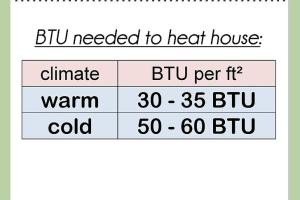Mastering BTU: Your Comprehensive Guide to Calculating BTU Per Square Foot

-
Quick Links:
- Introduction
- Understanding BTU
- Importance of BTU Calculation
- Factors Influencing BTU Requirements
- How to Calculate BTU Per Square Foot
- Step-by-Step Guide to BTU Calculation
- Case Studies and Examples
- Expert Insights
- Common Mistakes in BTU Calculation
- Conclusion
- FAQs
Introduction
When it comes to ensuring your home is comfortable year-round, understanding how to calculate BTU (British Thermal Unit) per square foot is essential. This measurement is crucial for selecting the right heating or cooling systems. In this comprehensive guide, we will unravel the complexities of BTU calculations, providing detailed insights, practical examples, and expert advice.
Understanding BTU
BTU stands for British Thermal Unit, a unit of energy that describes the amount of heat required to raise the temperature of one pound of water by one degree Fahrenheit. In the context of heating and cooling, BTUs help determine how effectively a system can regulate temperature in a given space.
Importance of BTU Calculation
Calculating the correct BTU for your space is vital for several reasons:
- Energy Efficiency: Proper BTU calculation ensures that HVAC systems run efficiently, reducing energy consumption and costs.
- Comfort: An accurately sized system provides consistent comfort without overheating or underheating.
- Longevity: Oversized or undersized systems can lead to frequent breakdowns and reduced lifespan.
Factors Influencing BTU Requirements
Several factors affect the BTU requirements for a space:
- Room Size: The larger the room, the more BTUs are required.
- Insulation: Well-insulated homes require fewer BTUs than poorly insulated ones.
- Windows: The number and size of windows significantly impact heat loss and gain.
- Climate: The local climate affects heating and cooling needs.
How to Calculate BTU Per Square Foot
Calculating BTUs per square foot involves a straightforward formula:
BTU = Area (sq. ft.) × BTU per square foot
The average BTU needed per square foot can vary based on climate and insulation. A common estimate is:
- Heating: 30-60 BTU per square foot
- Cooling: 20-40 BTU per square foot
Step-by-Step Guide to BTU Calculation
Step 1: Measure Your Space
Begin by measuring the length and width of the room to get the area in square feet.
Step 2: Determine Your BTU Needs
Refer to the average BTU per square foot based on your climate and insulation quality.
Step 3: Apply the Formula
Plug your area and BTU per square foot into the formula, and calculate.
Step 4: Adjust for Specific Factors
Make adjustments based on factors like high ceilings, large windows, or poor insulation.
Case Studies and Examples
Consider the following example:
A 1,000 sq. ft. home in a moderate climate with good insulation:
Calculation:
1,000 sq. ft. × 30 BTU/sq. ft. = 30,000 BTUs needed for heating.
This example illustrates how simple calculations can guide your HVAC system choice.
Expert Insights
Experts recommend consulting with HVAC professionals for precise calculations, especially for larger or complex spaces. Their experience can help tailor solutions to specific needs.
Common Mistakes in BTU Calculation
- Ignoring insulation quality
- Not accounting for sunlight exposure
- Using outdated BTU estimates
Conclusion
Calculating BTU per square foot is a fundamental skill for homeowners and builders alike. By understanding the principles outlined in this guide, you can ensure your heating and cooling systems are appropriately sized for comfort and efficiency.
FAQs
- What is a BTU? A BTU is a measurement of energy used to describe heating and cooling capacity.
- How many BTUs do I need for a 2000 sq. ft. house? Typically, you would need between 60,000 to 120,000 BTUs, depending on insulation and climate.
- Can I calculate BTUs for a multi-story home? Yes, calculate each floor separately and sum the total.
- What factors affect BTU calculations? Room size, insulation, windows, and climate play significant roles.
- How often should I reassess my BTU needs? It’s advisable to reassess during major renovations or changes in usage.
- Is there a specific tool for BTU calculation? Yes, there are online calculators available, but manual calculation is also straightforward.
- How does climate influence BTU needs? Colder climates generally require more heating BTUs, while warmer climates need more cooling BTUs.
- What is the difference between heating and cooling BTU needs? Heating BTUs focus on warmth needed, while cooling BTUs address heat removal.
- Are BTU calculations necessary for small spaces? Yes, even small spaces can benefit from precise BTU calculations.
- Can incorrect BTU calculations lead to problems? Yes, it can lead to discomfort, high energy bills, and mechanical failures.
Random Reads
- Making small urls 11 tools to create shorter web links
- How to open microsoft paint
- How to open notepad
- How to open php files
- How to summon vehicle destiny 2
- How to submit a question to wikianswers
- How to turn your sim into a vampire
- How to turn up hot water heater
- Recover secure hacked hotmail account
- How to make dragon armor in skyrim